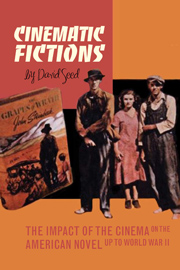Book contents
- Frontmatter
- Contents
- Introduction
- 1 Beginnings
- 2 Modernist Experiments: Gertrude Stein and Others
- 3 H.D. and the Limits of Vision
- 4 Ernest Hemingway: The Observer's Visual Field
- 5 Success and Stardom in F. Scott Fitzgerald
- 6 William Faulkner: Perspective Experiments
- 7 John Dos Passos and the Art of Montage
- 8 Dreiser, Eisenstein and Upton Sinclair
- 9 Documentary of the 1930s
- 10 John Steinbeck: Extensions of Documentary
- 11 Taking Possession of the Images: African American Writers and the Cinema
- 12 Into the Night Life: Henry Miller and Anaïs Nin
- 13 Nathanael West and the Hollywood Novel
- Bibliography
- Index
10 - John Steinbeck: Extensions of Documentary
- Frontmatter
- Contents
- Introduction
- 1 Beginnings
- 2 Modernist Experiments: Gertrude Stein and Others
- 3 H.D. and the Limits of Vision
- 4 Ernest Hemingway: The Observer's Visual Field
- 5 Success and Stardom in F. Scott Fitzgerald
- 6 William Faulkner: Perspective Experiments
- 7 John Dos Passos and the Art of Montage
- 8 Dreiser, Eisenstein and Upton Sinclair
- 9 Documentary of the 1930s
- 10 John Steinbeck: Extensions of Documentary
- 11 Taking Possession of the Images: African American Writers and the Cinema
- 12 Into the Night Life: Henry Miller and Anaïs Nin
- 13 Nathanael West and the Hollywood Novel
- Bibliography
- Index
Summary
Steinbeck before The Grapes of Wrath
The flourishing of documentary gives us a context within which to situate the most famous works of John Steinbeck. Indeed there is some evidence that he planned The Grapes of Wrath to be a photo-text and, if so, he was picking up on a two-media kind of reportage which was becoming popular in the 1930s. Agee and Evans did most of their work for Let Us Now Praise Famous Men in 1936, the same year in which Steinbeck produced his articles on the migrant workers of California, which were to lead ultimately to The Grapes of Wrath. He was invited to write these pieces by the editor of the San Francisco News and they were later published in pamphlet form with photographs by Dorothea Lange under the title Their Blood is Strong. It has been argued convincingly by Carol Shloss that these essays followed in tracks well laid out by the reports on migrant workers' camps by Paul Taylor and Lange, and for the most part they simply rehearse facts and figures. One exception, however, is the second article in the series, which takes the reader on a guided tour of one of these camps. Steinbeck acts on the reader's assumed need to see by transforming himself into a verbal camera while keeping up a running commentary. First he locates the typical camp near a water source, then he gives us the long shot: ‘from a distance it looks like a city dump, and well it may, for the city dumps are the sources for the material of which it is built.
- Type
- Chapter
- Information
- Cinematic FictionsThe Impact of the Cinema on the American Novel up to World War II, pp. 194 - 211Publisher: Liverpool University PressPrint publication year: 2009



